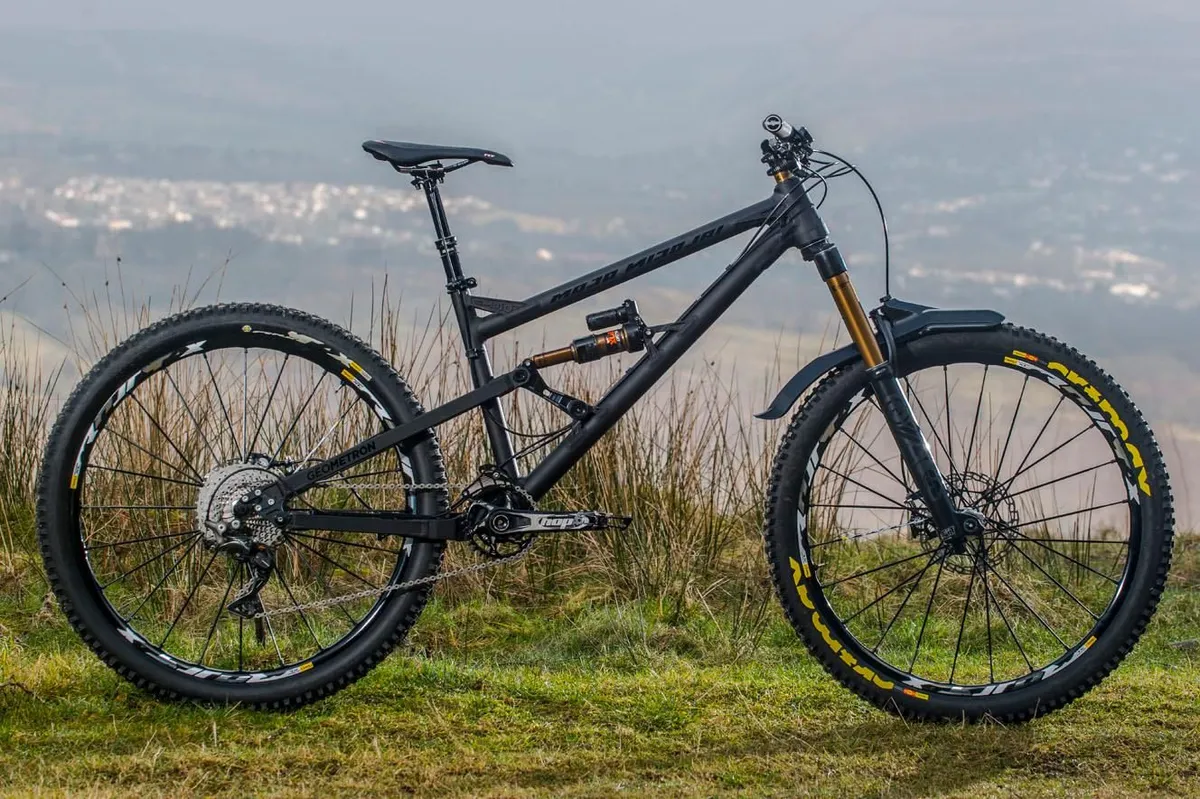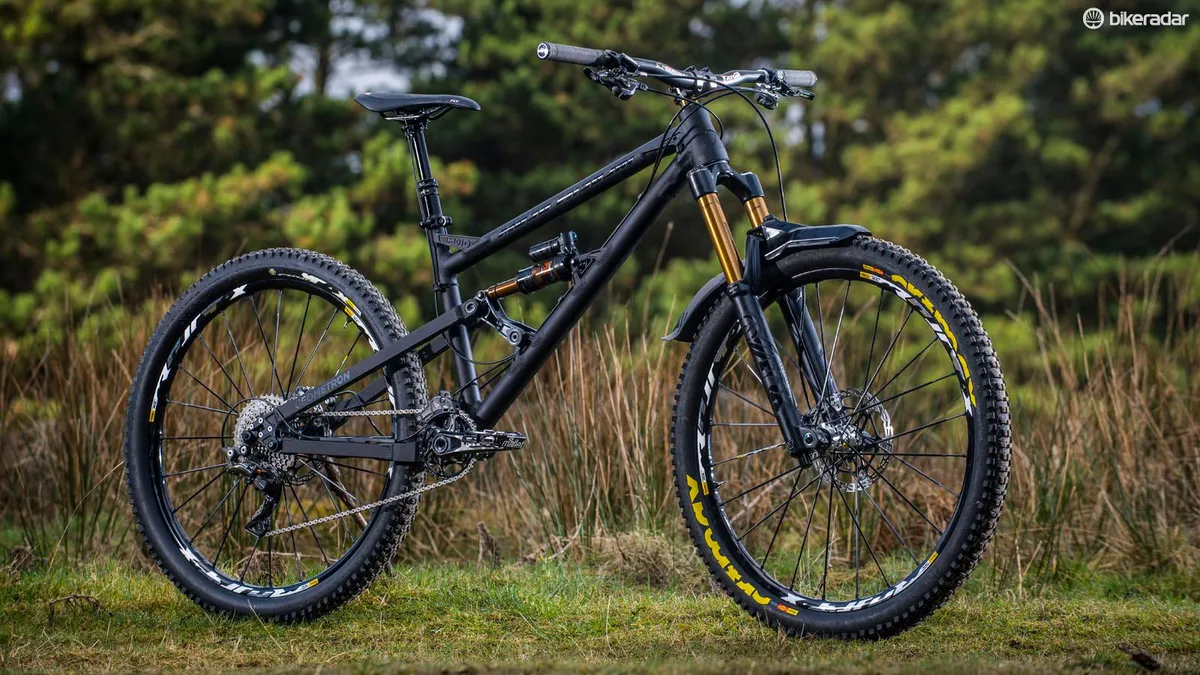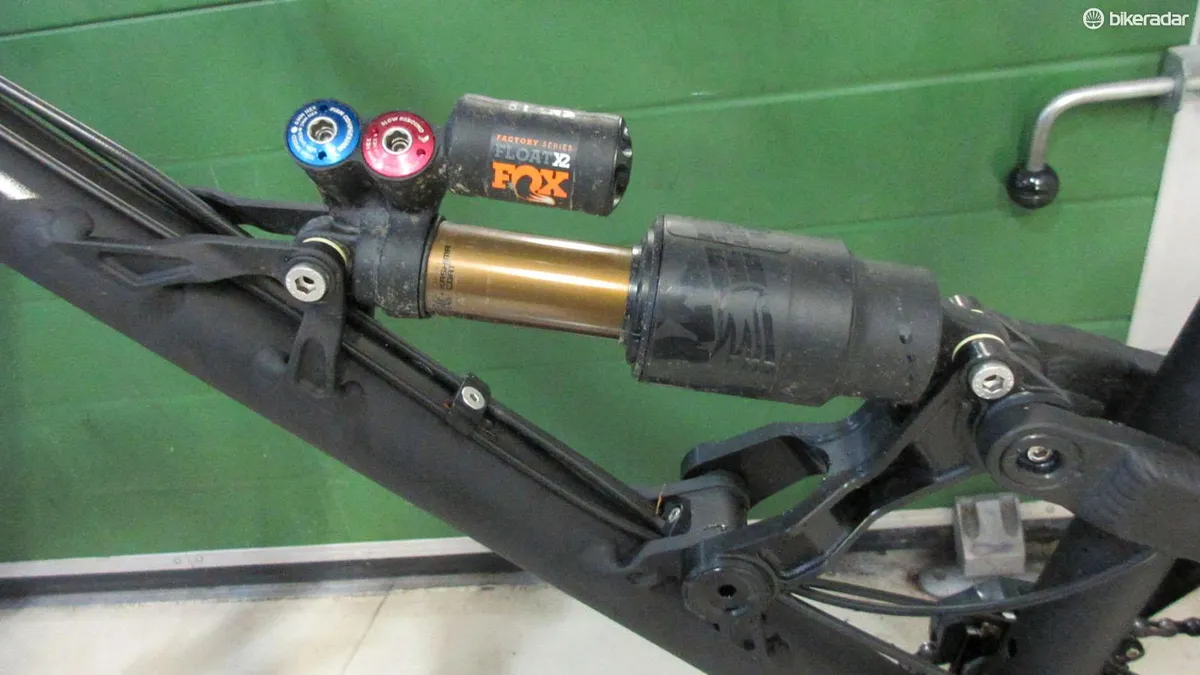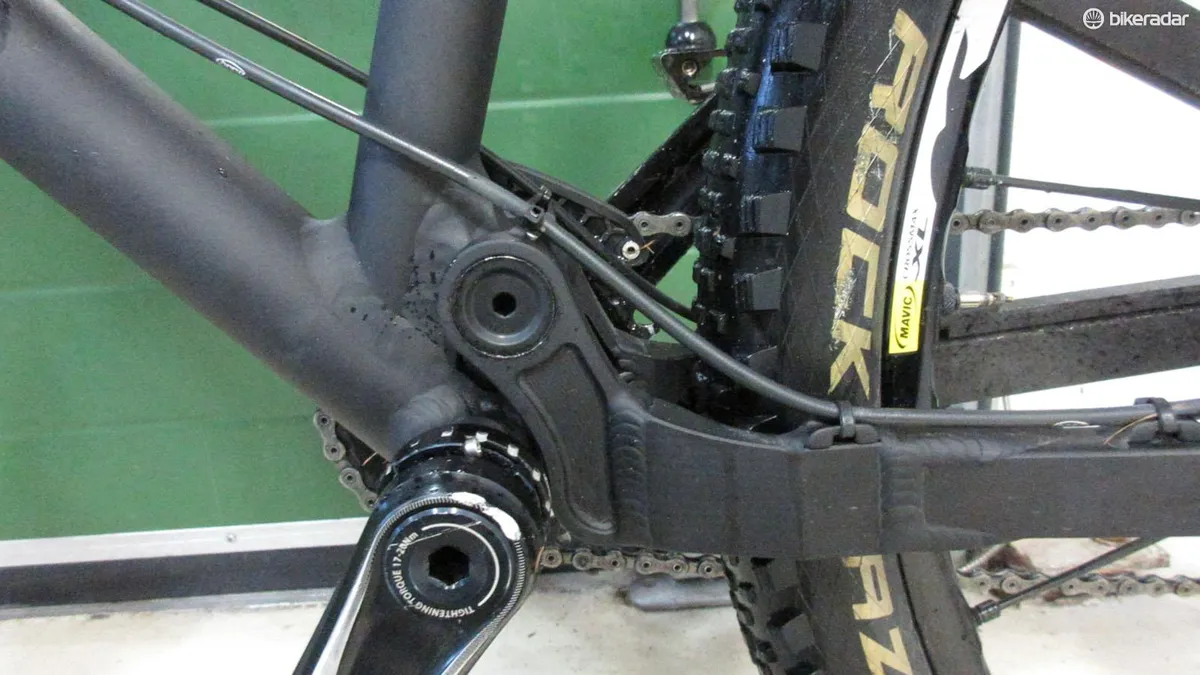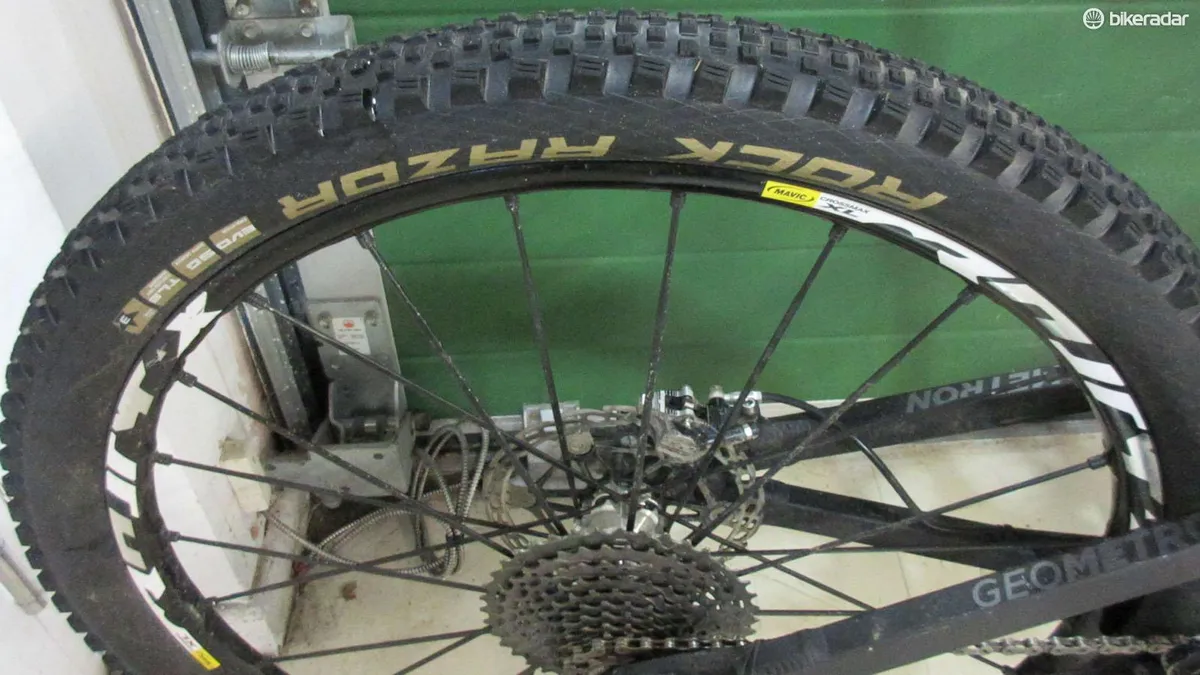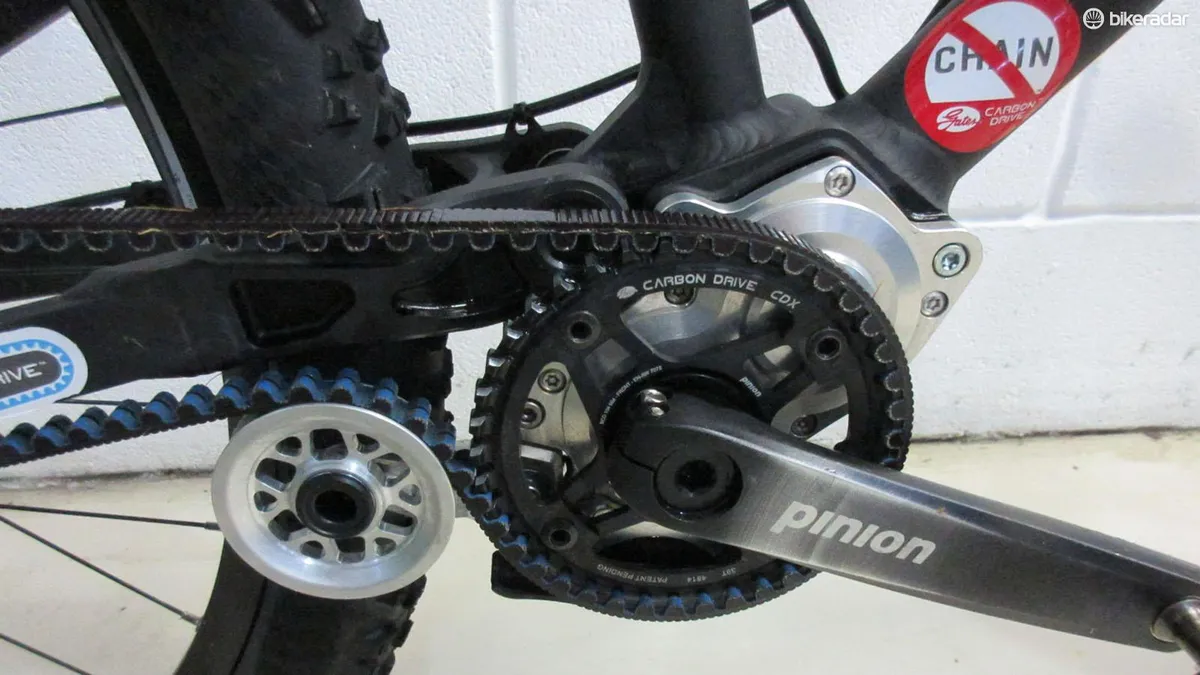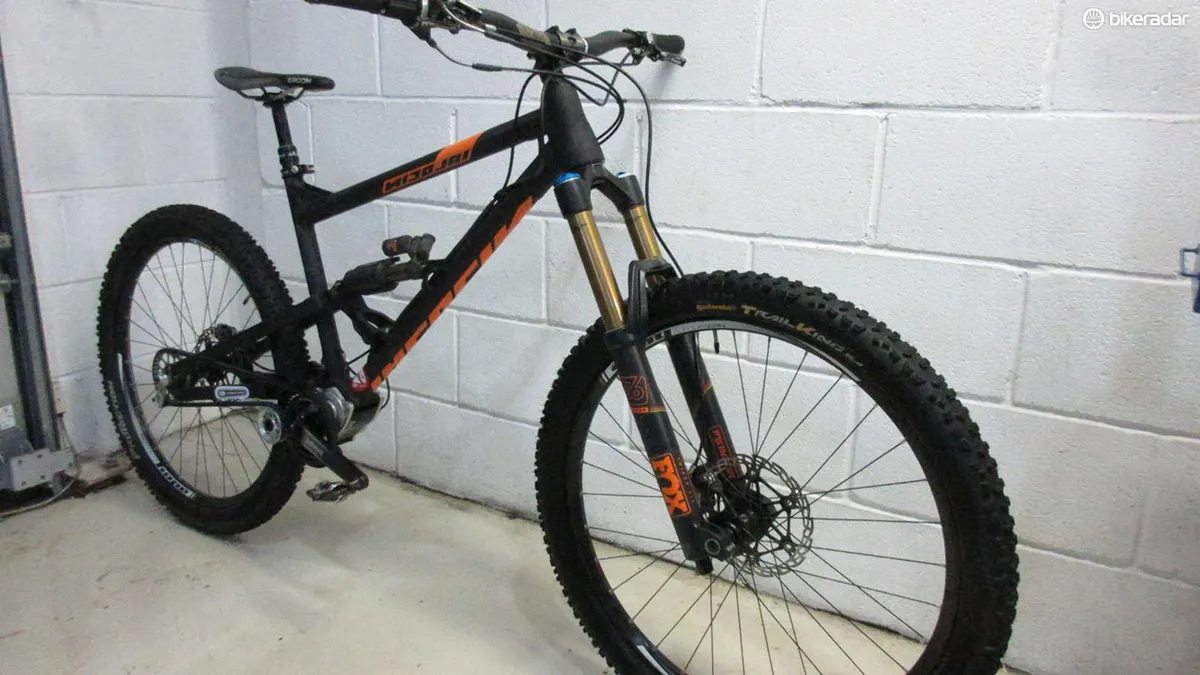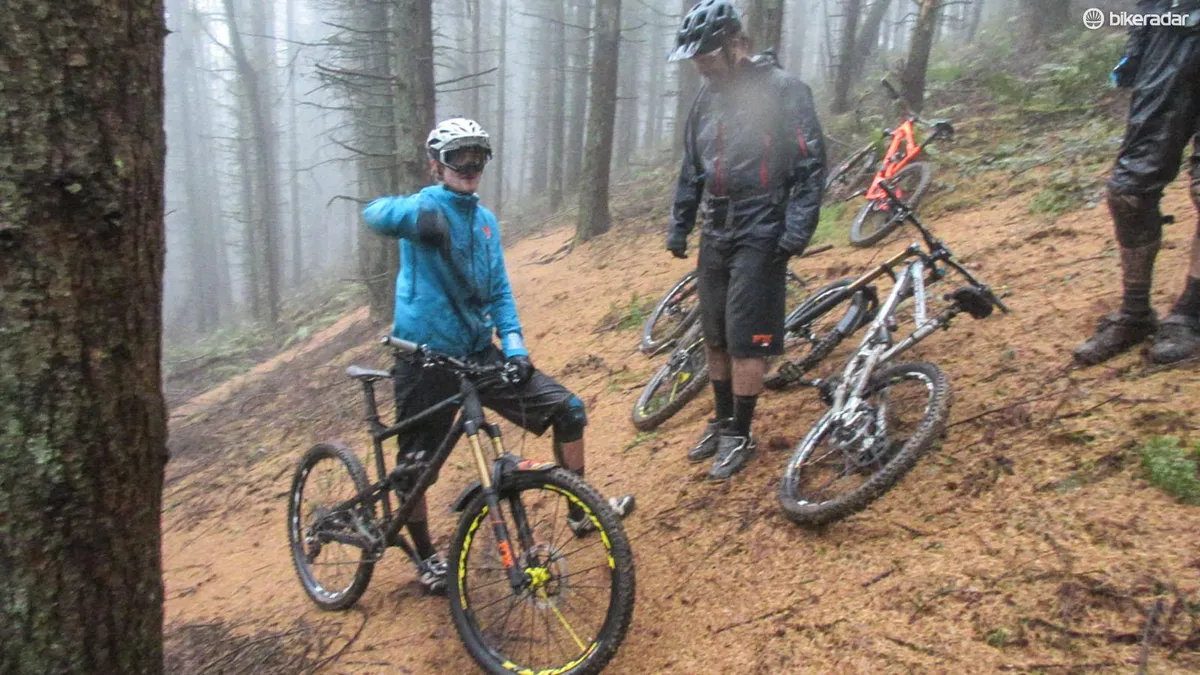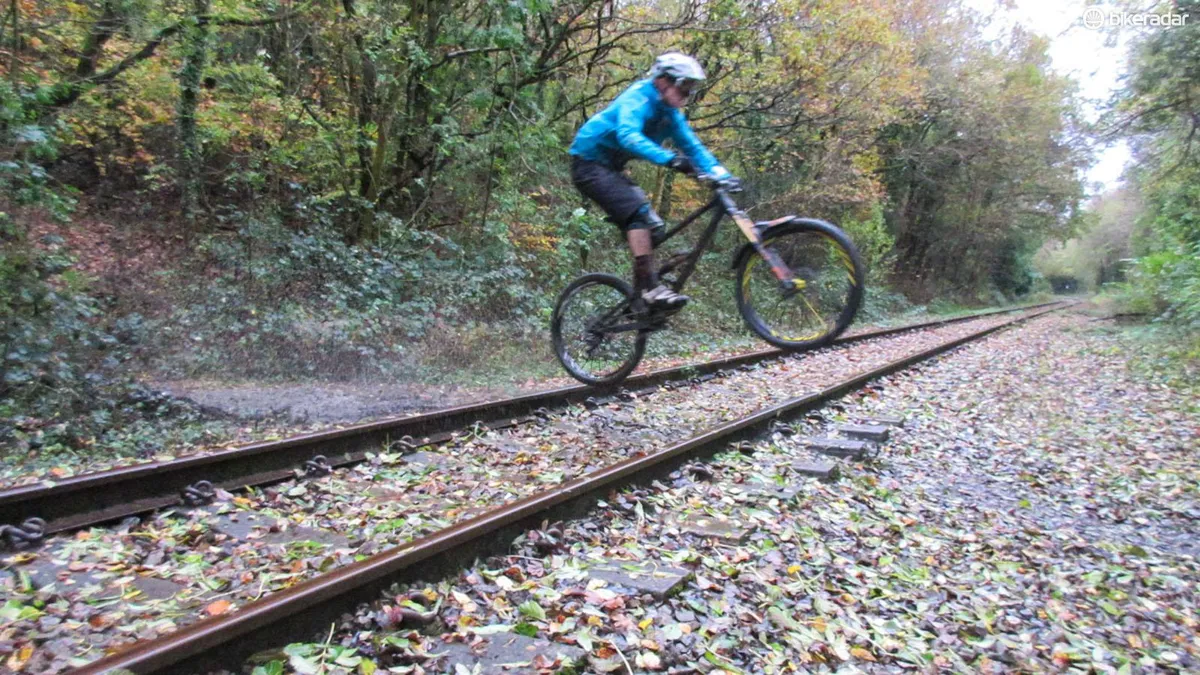When it comes to mountain bike geometry, what would have seemed extreme a few years ago is now commonplace. Bikes have been getting longer and slacker, while stem length has quite literally been cut in half.
So does that mean there’s no room left for development? UK based suspension expert and Fox Shox distributor Mojo would disagree.
In collaboration with German master fabricator Nicolai, the ‘GeoMetron’ project is a radical departure from what even the most progressive mainstream brands are offering. Driven by head-honcho Chris Porter, the GeoMetron bike takes geometry trends of the past few years and extrapolates them decades into the future, combining rulebook-flouting geometry with the latest in suspension technology to create a truly unique bike.
Never content to rest on groundbreaking laurels, the latest machines coming out of this hothouse of ideas takes two further strides away from convention.
One model incorporates a derailleur-free Pinion gearbox, while the other combines super-slack geo with 29er wheels. Now that’s a bold recipe.
We ventured into deepest darkest Wales to ride these bikes back to back to see whether the hype lives up to reality. Does either of these bonkers bikes actually ride well? Could they really be the future?
What the hell is a GeoMetron anyway?
The bikes are based around Nicolai’s tried and tested Ion16 platform. That gives you a handmade-in-Germany chassis made of alloy, using a Horst link four-bar rear end.
If machined metal and perfect fishscale welds makes you feel warm and fuzzy then you’d better be sitting down before you take a look at these machines. In collaboration with Mojo, Nicolai pushed its frame-making know-how to the limits, stretching the chassis to previous unknown extremes, with radically long front centres and head angles that make downhill bikes look a bit twitchy.
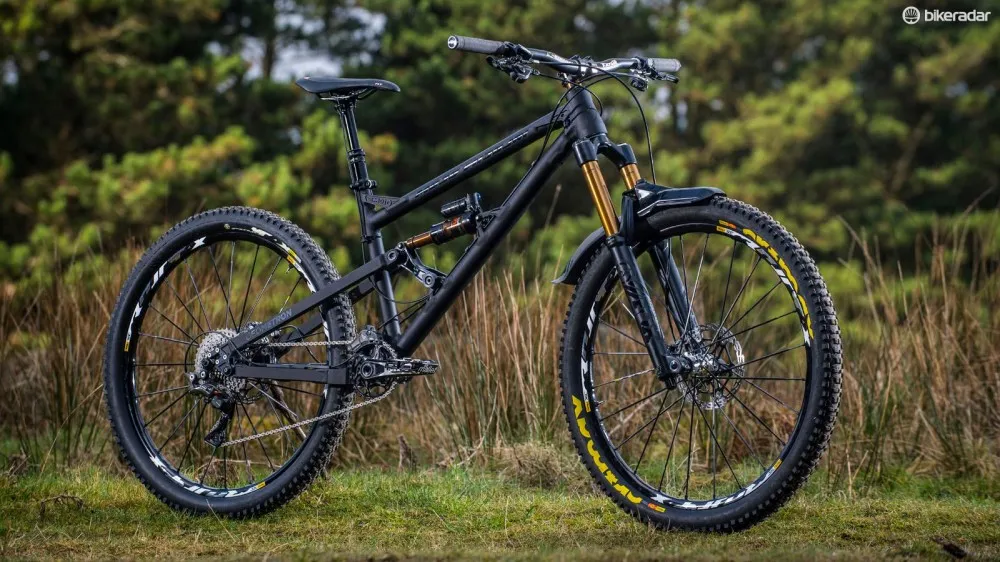
The GeoMetron plays fast and loose with the mountain bike design handbook
Mojo then sprinkles on suspension and setup know-how, plus in-depth setup sessions for the buyer to ensure the both bike and rider run at their optimum. It’s quite possibly the most painstaking customer support ever offered by any bike brand.
First up, I rode the standard GeoMetron. Mojo offers three sizes, amusingly named Long, Longer, and Longest. You can guess what that means.
At 6ft 3in, I opted for the longest size, as did Tom Marvin, the slightly shorter technical editor of our sister mag What Mountain Bike, who was on the gearbox-equipped Pinion bike. After setting up suspension with Porter's expert help, we both hit the trails to see what these bikes were like where it really matters.
Isn't a long, slack bike rubbish in the corners?
With a gigantic 1305mm wheelbase (Longest size), you might imagine the GeoMetron handles like a barge, unable to make it round tight bends. In reality, though, it’s about 100mm longer than average for an XL enduro bike, which is only about 8 percent extra wheelbase.
More to the point, the long reach figure (520mm) and slack head angle (63 degrees) make for extremely confident handling, especially in the tight corners – corners which have had me wrestling at the controls on more conventional bikes.
Video: bikeradar's seb stott takes the geometron for a spin
The long chainstay (445mm) is part of this story too. Although it boosts the wheelbase even further, it keeps the handling more predictable when the back end steps out of line, allowing big slides to be held under control. This slideability has a side benefit too: it’s enormous fun!
No doubt, the long wheelbase is more unwieldy on super-tight switchbacks, and I had to make an extra conscious effort to weight the front end to avoid it washing. This takes some getting used to, and can be more tiring on the arms.
So what’s special about the suspension?
My big wheeled GeoMetron used a 180mm version of Fox’s 36 RC2 fork, which was a revelation (no pun intended) in itself. The 180mm 36 uses a much bigger negative air spring than the more familiar 160mm version, resulting in a superbly sensitive beginning stroke, before ramping up smoothly through the mid-stroke to provide enormous support when pushing hard into corners. Simply put, it’s the best fork I’ve ever ridden.
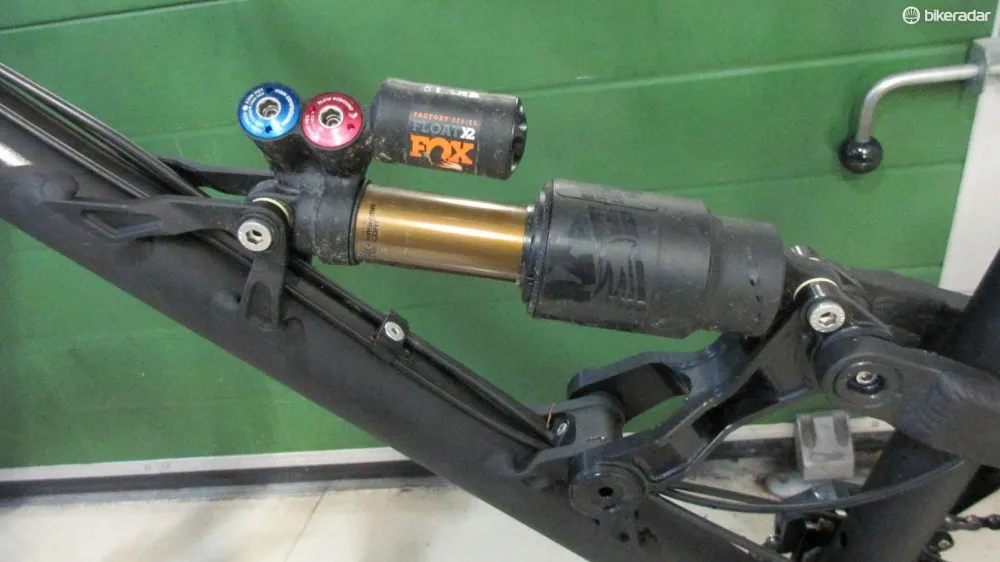
Float X2 shocks and Nicolai's Horst-link design perform superbly
Out back, the Fox Float X2 shock works a treat in Nicolai’s Horst-link housing. The combined suspension action is supple off the top and smoothly progressive, matching the front.
When set up properly with Chris’ help, suspension performance is absolutely superb: tracking the ground sensitively, while ramping up enough to handle the big g-outs and cornering loads on our test track.
Doesn't that mean it’s a pig on the climbs?
Nope. The long chainstay and super-steep (77-degree) seat angle mean you can really attack super-steep climbs comfortably. It’s not light, there’s no lockout and the suspension is compliant rather than ruthlessly efficient, but the geometry allows for seated spinning on the steepest pitches, while the supple suspension deals with the bumps.
What’s with the big-wheeled one?
The 29er GeoMetron uses remarkably similar geometry figures to the 650b bike. The head angle and bottom bracket height are identical, while the chainstay is just 5mm longer at 450mm and the reach is just 7mm shorter.
The 29er uses a standard 51mm offset fork, as opposed to the 44mm offset version used on the 650b bike. This compensates for the higher front axle, resulting in a trail figure that's almost identical.
Related: Pushing the limits of fork offset: an experiment
I was able to keep the bar height similar too, and the suspension kinematics kept as close as possible. It uses a virtually identical leverage-curve, although the axle-path is inevitably less rearward due to the higher rear axle and similar pivot placement.
Perhaps the most noticeable difference between the two was the shorter 160mm fork on the 29er, which felt noticeably harsher at the top of the stroke than the 650b’s 180mm masterpiece.
Okay, but a ridiculously long, slack 29er must handle like a barge…
No, not really. In fact, it was striking how similar the handling of the two bikes was. Keeping the head angle the same and the other geometry figures virtually identical delivers the same kind of terrain-shrugging stability and confidence we found on the 650b brother.
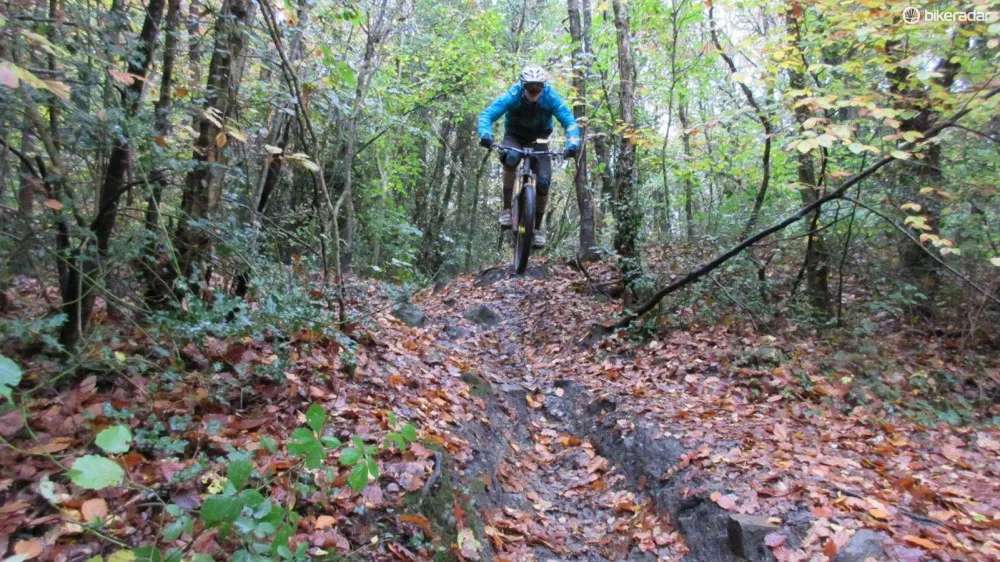
Steep and slippery terrain is dealt with confidently aborard the GeoMetron
It was a little harder to slow down into corners, but this could be addressed to some extent with bigger brakes. Perhaps it took slightly more effort to get round the tight corners, but the similar trail figure and head angle meant we could stick it into the bends really aggressively to rail it round.
Even in back-to-back comparison, we were pushed to notice much of a handling difference between the two.
We took all the same lines, and couldn’t wheedle-out any of the predicted awkward handling manners from the slack 29er. In the straights, we could probably carry more speed on the 29er, and when traversing rough terrain it felt more calm and smooth.
So the 29er is better then?
Well, it’s hard to say. We slapped a stopwatch on each bike, and on this occasion found the 29er to be around 2 seconds slower over the 3.5 minute test course.
However, the weather deteriorated as the day went on, and we reckon the 29er had a much more slippery surface to contend with. We suspect that in dryer conditions or a rougher course the wagon-wheeler might just pull ahead.
Didn’t you mention a gearbox bike? What’s that one like?
Nicolai has a reasonably long history of incorporating the Pinion gearbox into its bikes, and alongside the 29er Geomotron, a Pinion geared version was available for us to ride.
The Pinion is a self-contained planetary gearbox, in this case offering 12 gears covering around the same range as a 2x10 set up – plenty then for the steep climbs and wild descents of South Wales.
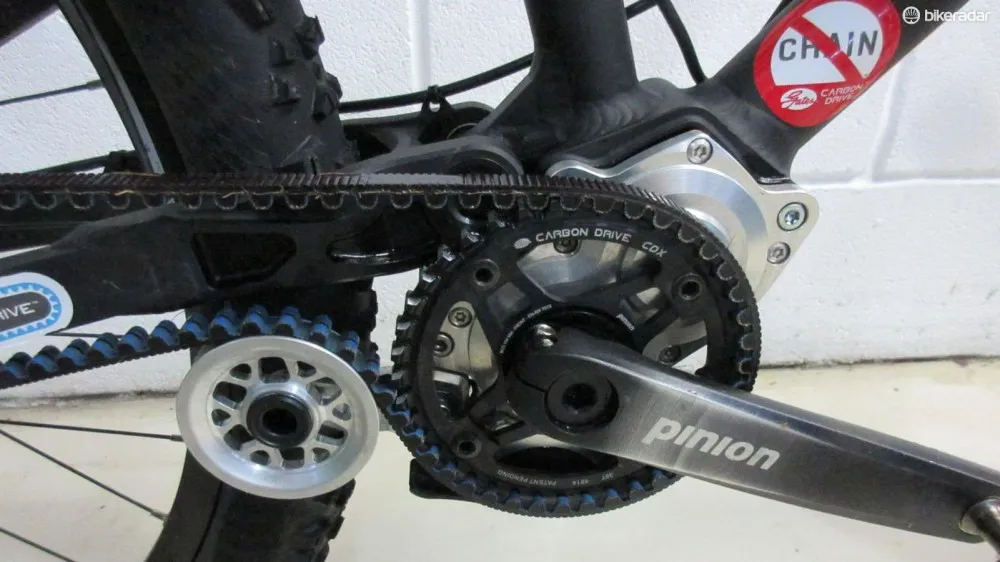
The gearbox keeps weight low and central, and away off of the wheels
The Pinion adds around a kilo of weight, noticeable when picking the bike up, but less so when riding. The weight is centralized on the bike, and is low too – without a cassette and rear derailleur, the weight balance of the bike is improved, even if overall weight isn’t.
The rear wheel on our test bike was driven by a Gates Carbon Drive belt, with a heavily spring loaded roller providing tension and specific chain ring and sprocket, with a guiding ‘CenterTrack’ to keep everything where it should be.
Gear shifting is done via a grip-shift set up, with two cables exiting the shifter – rather than a sprung derailleur system, there’s no spring to control the release of cable tension in the Pinion.
What’s the point of a gearbox?
While on steep, slippy and relatively unknown trails, it’s hard to draw too many conclusions, the centralised weight of the Pinion gave the already planted GeoMetron even deeper roots.
Leaning the bike into corners results in bags of stability - almost like the BB had been dropped a touch. Having the bulk of the weight unsprung (independent of suspension movement, unlike a cassette and derailleur) also marginally aids suspension sensitivity.

Despite the length, the GeoMetron is a capable corner carver. Just remember to lean forward!
Drive through the belt felt very similar to that of a chain – there’s no noticeable stretch and the drive is smooth. That said, there is a whirring feel to the Pinion that you feel through your feet.
While the Pinion system is efficient, psychologically this feels a little odd, and from past experience of other internally geared systems, it’s not one I’m a fan of. The Pinion has its own freewheel, and our set up used a regular rear hub too, so pedal engagement was relatively poor – but, this mean that hard impacts on the suspension meant very little pedal kickback was transmitted.
While the Pinion system has its advantages in terms of stability and suspension, and certainly worked well, we weren’t impressed with the shifter. While its grip isn’t smooth, there was less traction in mucky conditions than there would be from a full grip, and the difference in feel between the right hand shifter side of the bar and the regular grip on the left felt odd.
Should I buy one then?
Well, if you have £5900 to spend, then perhaps you should. For that, you can get a standard GeoMetron with a day of one-on-one suspension setup with a Mojo technician – which is a big help in getting the most out of your bike. It’s still not quite what we’d call a bargain, but you can’t get this kind of suspension setup and radical geometry anywhere else.
The geometry definitely won’t suit everyone, though. You really have to ride it aggressively to get the most from the bike, and that’s pretty hard work after a while.
It climbs well on steep terrain, but probably wouldn’t be much fun for an all-day pootle round your local trail centre. It’s a steep terrain specialist, but the performance it delivers in its natural habitat is tremendous.
